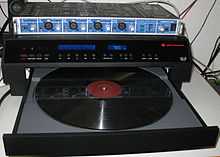Laser turntable

A laser turntable (or optical turntable) is a phonograph that plays LPs (and other gramophone records) using laser beams as the pickup – the way a compact disc player plays CDs – instead of using a stylus as in conventional turntables.
History
William K. Heine presented a paper entitled A Laser Scanning Phonograph Record Player to the 57th Audio Engineering Society (AES) convention in May 1977. The paper details a method developed by Heine that employs a single 2.2 mW Helium–neon laser for both tracking a record groove and reproducing the stereo audio of a phonograph in real time. In development since 1972, the working prototype was named the "LASERPHONE" and the methods it used for playback was awarded U.S. Patent 3,992,593 on 16 November 1976.[1] Heine concluded in his paper that he hoped his work would increase interest in using lasers for phonographic playback.
Finial
Four years later Robert S. Reis, a graduate student in engineering at Stanford University, wrote his master's thesis on "An Optical Turntable".[2] In 1983 he and fellow Stanford electrical engineer Robert E. Stoddard founded Finial Technology to develop and market a laser turntable, raising $7 million in venture capital. In 1984 servo-control expert Robert N. Stark joined the effort.[3]
A non-functioning mock-up of the proposed Finial turntable was shown at the 1984 Consumer Electronics Show (CES), generating much interest and a fair amount of mystery, since the patents had not yet been granted and the details had to be kept secret. The first working model, the Finial LT-1 (Laser Turntable-1), was completed in time for the 1986 CES. The prototype revealed an interesting flaw of laser turntables: they are so accurate that they play every particle of dirt and dust on the record, rather than pushing them aside as a conventional stylus would. The non-contact laser pickup does have the advantages of eliminating record wear, tracking noise, turntable rumble and feedback from the speakers. The projected $2500 street price (later raised to $3786 in 1988) limited the potential market to professionals (libraries, radio stations and archivists) and a few well-heeled audiophiles.[4]
Unfortunately for Finial, the laser turntable development exactly coincided with both a major economic recession and the perfection and introduction of the Digital Compact Disc, which soon began flooding the market at prices comparable to LPs (with CD players in the $300 range). Vinyl record sales plummeted, and many existing turntable manufacturers went out of business as a result.
The Finial turntable never went into production. After a few hand-built (and finicky)[5] prototypes were completed and shown, tooling delays, component unavailability (in the days before cheap lasers), marketing blunders, and high development costs kept pushing back the release date. With over US$20 million in venture capital invested, Finial was faced with a dilemma: to forge ahead with a selling price that was too high for most consumers, or to gamble on going into mass production at a much lower price and hoping the market would lower costs.
ELP
In late 1989 Finial's investors finally cut their losses and liquidated the firm, selling the patents to Japanese turntable maker BSR, which became CTI Japan which in turn created ELP Japan for continued development of the "super-audiophile" turntable. After eight more years of development the laser turntable was finally put on sale in 1997 as the ELP LT-1XA Laser Turntable, with a list price of US$20,500 (in 2003 the price was lowered to US$10,500).[6] The turntable, which uses two lasers to read the groove and three more to position the head, does allow one to vary the depth at which the groove is read, possibly bypassing existing record wear. It will not, however, read clear or colored vinyl records.[7]
IRENE system
A completely separate technology[8] has been developed by physicist Carl Haber. Installed in the Library of Congress late in 2006, the IRENE System uses a two-dimensional camera rotating around the record, which takes detailed photographs of the grooves. Software then uses the digital images to reconstruct the sound. IRENE often produces a large amount of hiss with the recording, but it is very capable of removing pops and clicks produced by scratches on the record surface. IRENE will only read lateral information (monophonic), but a three-dimensional scanner project is underway that will handle stereophonic and quadraphonic records, in addition to historical hill-and-dale recordings.[9] Detailed descriptive posters can be downloaded from the IRENE Web site. These are not being developed for sale.
References
- ↑ "Patent US3992593 – Disc phonograph record playback by laser generated diffraction pattern – Google Patents". Google.com.
- ↑ "Robert Reis Resumé". Senderogroup.com.
- ↑ "Robert N Stark – Inventor Patent Directory, Page 1". Patent.ipexl.com.
- ↑ Orban, Robert. "Maintaining Audio Quality in the Broadcast Facility – 2008 Edition". Retrieved 25 June 2008.
Page 39 – Production facilities specializing in high-quality transfer of vinyl to digital media should consider supplementing their conventional turntable with an ELP Laser Turntable(9) Instead of playing disks mechanically, this pricey device plays vinyl without mechanical contact to the disk, using laser beams instead.
- ↑ Steven R. Rochlin. "Bill Gaw AA Chapter 55: ELP Laser Turntable". Enjoythemusic.com.
- ↑ "ELP Laser Turntable: plays vinyl records without a needle, presented by Audioturntable, Ltd". Audioturntable.com.
- ↑ Valin, Jonathan (24 November 2008). "ELP LT-1LRC Laser Turntable". The Absolute Sound.
- ↑ "You Can Play the Record, but Don't Touch". NPR.
- ↑ "IRENE project Web site". Irene.lbl.gov.
External links
- ELP Japan website
- ELPJ – About the laser turntable
- Record scanning – Ofer Springer
- Record scanning using IRENE – Sound Reproduction R & D Home Page
- Record scanning – VisualAudio: An optical technique to save the sound of phonographic records
- Only One Company in the World for Laser Record Players to Play Vinyl RecordsJapan External Trade Organization
- United States Patent US3992593
- United States Patent US4870631
- United States Patent US4972344
| ||||||||||||||||||||||||||